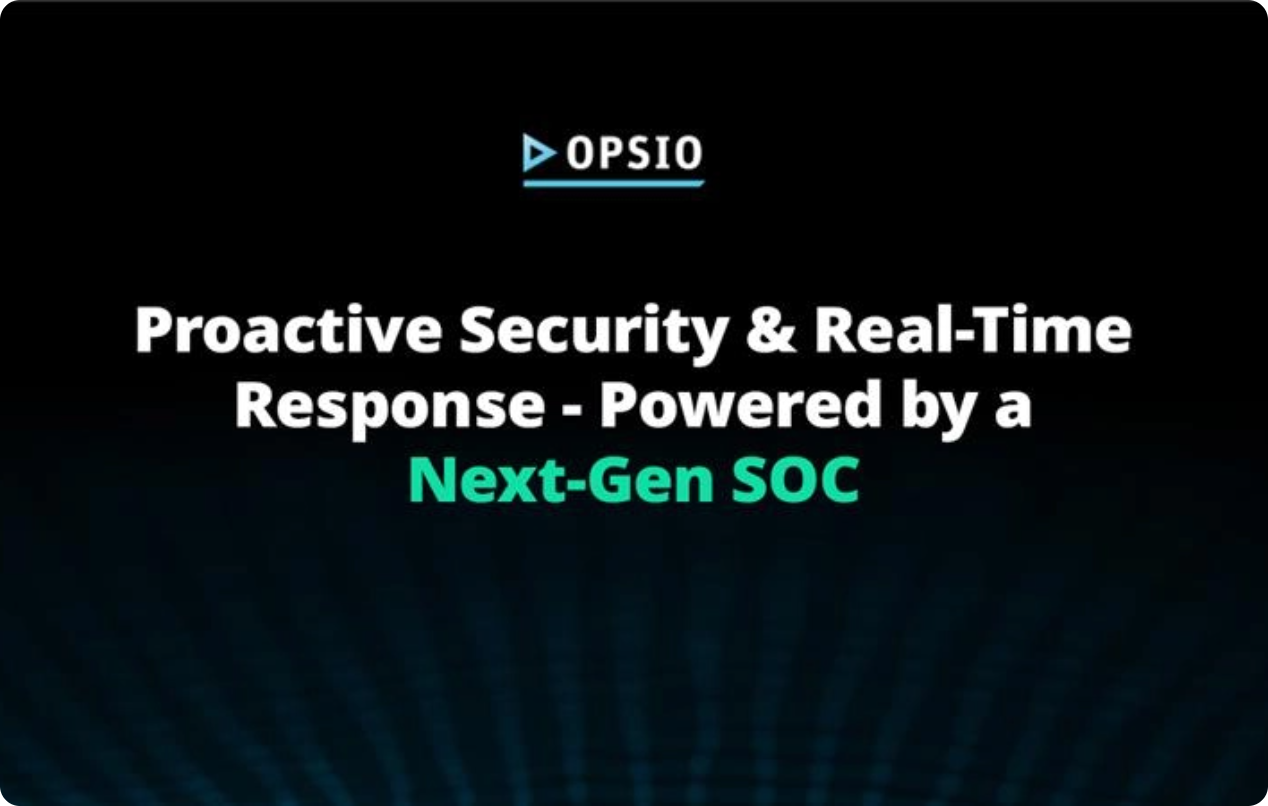SOC Security Services for 24 7 Threat Monitoring
Mitigate Security Risks with Opsio’s SOC Services
Opsio empowers enterprises with strategic measures to enhance security posture with its team of SOC experts.
Introduction
Accelerate business operations with SOC security services
Enterprises need to prioritize their security with the growing volume of cyberattacks, but establishing robust security operations can be challenging. Security teams can easily get overwhelmed when bombarded with increased amounts of alerts, which may or may not be accurate most of the time. By choosing Opsio’s SOC security services, businesses can simplify their security approach by utilizing threat intelligence, triage processes to filter out legitimate threats, and automation.

Continuous and consistent
surveillance of operations
What are SOC security services?
Restore affected systems with SOC security services
An SOC security services provider like Opsio carefully analyzes the affected systems to patch vulnerabilities exploited during the cyberattack. Then, we redesign firewalls and security policies to ensure that they withstand future vulnerabilities. After content is restored from backups, the systems can be tested to make sure that they function properly. We help businesses maintain a record of the incident, the measures taken to resolve it, and the learnings gained from the process. Following this, our team helps enterprises develop and strengthen their SOC. Our services are tailored to not only enhance your security but also significantly minimize the chances of security-related issues in the future.
How do businesses benefit from SOC security services?
Avoid business disruption with SOC security services
Enterprises that depend on digital architecture are increasingly vulnerable to cyberattacks like data breaches, ransomware, and malware issues. In such a scenario, businesses can experience serious disruptions like downtime, loss of critical information, and corruption of sensitive data. SOC security service providers like Opsio, with their expertise, equip businesses with 24/7 monitoring, the identification of patterns that suggest malware or a breach, and employ measures to resolve such threats.
Our services
Robust SOC Security service to elevate your business’s resilience

Cyber resilience
Our services include ongoing monitoring of systems and networks for suspicious activity. If any errors or threats are found, our team follows a structured process to solve the issue, resulting in minimized downtime, restricted data loss, and operational impact.

Vulnerability analysis
Businesses often fail to analyze their operations to identify vulnerabilities. Opsio’s team conducts vulnerability analysis to identify security inefficiencies and employs measures to address the weaknesses.

Phishing testing
Opsio’s team conducts phishing testing by sending realistic-looking emails to employees within your organization to analyze how users interact, measure awareness, and identify individuals and departments susceptible to phishing attacks. Following that, we will deploy necessary measures to strengthen your organization’s defenses.

Load testing
We ensure that our Security Operations Centers (SOCs) are compliant with load testing standards. Opsio’s team regularly employs load testing to make sure that our SOC managed security services can handle increased traffic and withstand attacks.

Rapid incident response
With Opsio’s quick incident responses, organizations that face constant cybersecurity issues can benefit immensely. Our SOC security services can enable organizations to recover from cyberattacks by monitoring, and analyzing, which enables businesses to recover quickly from cybersecurity incidents.

Customized solutions
The security solutions that Opsio’s team offers are tailored based on the organization’s security concerns and requirements. Our team has the expertise to offer solutions that are industry-specific and efficient.
Key benefits
Ensure business continuity with SOC security services
- Improved security posture for enhanced business processes
- Comprehensive security support from our expert team
- SOC security services that evolve with advancements in AI and machine learning
- An expert team that ensures the security and resilience of the operational environment
- SOC security services tailored to your business requirements
- Continuous monitoring and analysis to ensure implementation of rapid responsive measures
- A professional team of SOC experts to maintain security against cyber threats.
- Accelerate your business’s ability to innovate and grow confidently in a digital environment

Industries we serve
Customised security solutions based on the industry
Technology Providers
Opsio’s SOC services utilize global threat data to stay secure from emerging attacks and enable providers to stay robust and tackle the latest cyber threats.
Public Sectors
Like any sector, public organizations are also susceptible to cyberattacks. Our SOC security service enables rapid resolution and containment, and minimizes the downtime of public services.
BFSI
SOC security services enable the safety of sensitive information and maintain secure transactions. Since the customers of BFSI firms place a high value on security above everything else, this allows them to earn customer trust and loyalty.
Telecom
Opsio’s SOC security services enable the detection of malware, and intrusions to eliminate downtime due to cyberattacks, enabling continued delivery of communication services.
Stay Ahead of the Cloud Curve
Get monthly insights on cloud transformation, DevOps strategies, and real-world case studies from the Opsio team.
Why choose Opsio?
Opsio, ensure business security and resilience
As a leading provider of SOC managed security services, Opsio has a proficient team that is equipped with SOC security expertise to strengthen your business’s security posture and resilience. Our team offers round-the-clock assistance to tackle unanticipated cyber threats, enabling you to stay confident.
SOC Evolution: Your Opsio Roadmap to Security Success
Customer Introduction
Introductory meeting to explore needs, goals, and next steps.
Proposal
Onboarding
The shovel hits the ground through onboarding of our agreed service collaboration.

Assessment Phase
Compliance Activation
Run & Optimize
SOC Security Services FAQ
What types of security services does your Security Operations Center (SOC) offer?
At Opsiocloud.com, our Security Operations Center (SOC) offers a comprehensive range of security services to ensure the protection of your organization’s digital assets. Our SOC is staffed with highly skilled and experienced cybersecurity professionals who are dedicated to monitoring, detecting, and responding to security incidents in real-time.
Some of the key security services that our SOC offers include:
1. 24/7 Monitoring: Our SOC operates round-the-clock to monitor your network, systems, and applications for any suspicious activity or potential security threats. This proactive monitoring allows us to quickly identify and mitigate security incidents before they escalate into major breaches.
2. Threat Detection and Analysis: Our SOC utilizes advanced threat detection tools and technologies to identify and analyze security threats in real-time. By continuously monitoring your network traffic and logs, we can quickly detect and respond to potential threats before they impact your organization.
3. Incident Response: In the event of a security incident, our SOC team is ready to respond swiftly and effectively to contain the threat, investigate the root cause, and implement remediation measures to prevent future incidents. Our incident response process is well-defined and follows industry best practices to ensure a timely and coordinated response.
4. Security Analytics: Our SOC leverages advanced security analytics tools to provide in-depth insights into your organization’s security posture. By analyzing security data and trends, we can identify vulnerabilities, assess risks, and recommend security enhancements to strengthen your overall security posture.
Overall, our SOC offers a comprehensive suite of security services to help organizations protect their digital assets and mitigate cybersecurity risks. With our experienced team of cybersecurity professionals and cutting-edge technologies, we are committed to providing top-notch security services to our clients.
Can your Security Operations Center (SOC) provide real-time threat monitoring and incident response services?
Yes, our Security Operations Center (SOC) is equipped to provide real-time threat monitoring and incident response services to ensure the security and integrity of your organization’s IT infrastructure. Our team of highly skilled and experienced IT consultants are constantly monitoring your network for any potential threats or vulnerabilities that could compromise your systems.
With the increasing sophistication of cyber threats, it is crucial for businesses to have a proactive approach to cybersecurity. Our SOC utilizes the latest technology and tools to detect and respond to security incidents in real-time, helping to minimize the impact of potential breaches on your organization.
Our incident response team is trained to quickly assess and contain security incidents, minimizing downtime and potential damage to your systems. We work closely with your internal IT team to ensure a coordinated and effective response to any security incidents that may arise.
In addition to real-time threat monitoring and incident response services, our SOC also provides ongoing security assessments and recommendations to help strengthen your organization’s overall security posture. By partnering with us, you can have peace of mind knowing that your organization is protected from the ever-evolving threat landscape.
Overall, our SOC is dedicated to providing the highest level of security services to our clients, ensuring that they are well-equipped to defend against cyber threats and safeguard their sensitive data.
How can your Security Operations Center (SOC) help my business stay compliant with industry regulations and standards?
As an IT consultant, I understand the importance of compliance with industry regulations and standards for your business. Maintaining compliance is not only crucial for avoiding costly fines and penalties, but it also helps to build trust with your customers and partners. This is where a Security Operations Center (SOC) can play a vital role in ensuring that your business stays compliant.
A SOC is a centralized unit that is responsible for monitoring, detecting, analyzing, and responding to cybersecurity incidents within your organization. By leveraging the expertise of SOC analysts and advanced technologies, your business can proactively identify and mitigate security threats that could potentially lead to compliance violations.
One of the key ways in which a SOC can help your business stay compliant is through continuous monitoring and threat detection. SOC analysts are trained to monitor your network and systems in real-time, looking for any suspicious activity that could indicate a potential security breach. By detecting and responding to threats promptly, a SOC can help prevent data breaches and other security incidents that could put your business at risk of non-compliance.
Additionally, a SOC can help your business align with industry regulations and standards by implementing best practices and security controls that are in line with these requirements. SOC analysts can conduct regular security assessments, audits, and compliance checks to ensure that your organization meets the necessary security standards.
Overall, a SOC can provide the expertise and resources needed to help your business stay compliant with industry regulations and standards. By partnering with a SOC, you can enhance your cybersecurity posture, minimize the risk of non-compliance, and ultimately protect your business from potential security threats.
